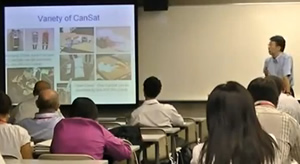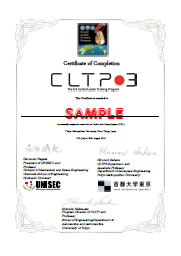|
| Date | Host University | Attendees |
| CLTP13 |
August 19 - 29, 2024 |
 |
10 participants, 7 countries
(Bosnia and Herzegovina, Croatia, Egypt, Ethiopia, Netherlands, Nepal, United Kingdom) |
| CLTP12 |
August 21 - September 1, 2023 |
 |
17 participants, 13 countries
(Bangladesh, Burkina Faso, Colombia, Egypt, Eritrea, Indonesia, Kazakhstan, Namibia, Nepal, Philippines, Taiwan, Zambia, Zimbabwe) |
| CLTP11 |
August 17-31,2022 |
 |
21 participants, 14 countries
(Bangladesh, Bosnia, Colombia, India, Kazakhstan, Kenya, Malaysia, Mexico, Mongolia, Nepal, Peru, Philippines, South africa, Thailand) |
| CLTP10 |
August 19-30, 2019
|
 |
15 Participants, 11 Countries
(Australia, Bhutan, Bulgaria, Cambodia, Colombia, Kenya, Morocco, Myanmar, Peru, Rwanda, Zimbabwe) |
| CLTP9 |
August 20-31, 2018
|
 |
7 participants, 5 countries
(India, Mongolia 2, Malaysia 2, UAE, Argentina) and 6 Japanese students. |
| CLTP8 |
September 7 - 16, 2017
|
 |
9 participants, 7 countries
(Nepal, Egypt, Malaysia, El-Salvador, Bolivia, Turkey, Japan) and 4 Japanese students. |
| CLTP7 |
September 21 - October 1, 2016
|
 |
8 participants from 7 countries
(Egypt, Peru, Mongolia, Nepal, Myanmar, Serbia, Dominica Republic)
|
| CLTP6 |
August 23-September 3, 2015
|
 |
8 participants from 8 countries
(Mexico, Egypt, New Zealand, Tunisia, Angola, Turkey, Bangladesh, Austria)
|
| CLTP5 |
September 8 -
19, 2014
|
 |
7 participants from 6 countries
(Egypt, Mexico, Mongolia, Korea, Peru, Japan)
|
| CLTP4 |
July 22 -
August 16, 2013
|  | 9 participants from 6 countries
(Angola, Bangladesh, Japan, Mexico, Mongolia, The Philippines)
|
| CLTP3 |
July 17 - August 20, 2012
|  | 10 participants from 9 countries
(Brazil, Egypt, Israel, Lithuania, Mongolia, Namibia, Nigeria, The
Philippines, Turkey) |
| CLTP2 | November 14 -
December 14, 2011
|  | 10 participants from 10 countries
(Ghana, Indonesia, Malaysia, Mongolia, Nigeria, Peru, Singapore, Thailand, Turkey, Vietnam)
|
| CLTP1 | February 14 - March 20, 2011 |
 | 12 participants from 10 countries (Algeria, Australia, Egypt, Guatemala, Mexico, Nigeria, Peru, Sri Lanka, Turkey, Vietnam) |
The CLTP is a self-supported program based on both participants partial payment and the donation by the third party (person).
Organization for the CLTP
Program Director:
Rei Kawashima, Chair, Committee for International Relations, UNISEC
Programme Committee:
-Yasuyuki Miyazaki, Nihon University and Chairperson of UNISEC
-Harunori Nagata, Hokkaido University and Vice Chairperson of UNISEC
-Ryu Funase, The University of Tokyo and Vice Chairperson of UNISEC
CLTP10:
Co-Organizers: Nihon University and UNISEC
Supervisor: Masahiko Yamazaki, Nihon University
Eligibility
- Academic researchers with a PhD degree who belong to universities or research institutes outside
Japan are eligible.
- Company employees who wants to use CLTP10 as an education and training program.


CanSat(HEPTA Sat) Lecture Series (Details of the program are subject to change without prior notice.)
- CanSat (HEPTA Sat) Building
- Basic CanSat(HEPTA Sat) System
- Solder parts on PCB and prepare antenna
- CanSat (HEPTA Sat) test
- Wired test for command and telemetry
- Wireless test for command and telemetry
- Descending from drone
- CLTP Basic Course – Lecture Series
One of the purposes of CLTP is to learn, through a miniaturized satellite, significance and values of the following basic systems:
- Introduction to and Overview of CanSat - Its Educational Significance
- Mission Subsystem

- Command and Data Handling (C&DH) subsystem and Power System
- Structures and Deployable
- Communication and Ground station
- Sensors and Actuators
- Ground Test and How to Feedback
- Ground-Field Test and Safety standards
It is also to study how to combine element technologies of these systems for satellite operation, which is called the assembly, integration and test (AI & T) in a broader sense. In addition, the CLTP has an important mission to develop human resources capable of teaching space engineering education, using CanSat(HEPTA Sat) in particular, after its completion.
 |
 Certificate of Completion Certificate of Completion
Certificate of Completion is awarded to each participant after completing the CLTP.
|

The graduates from the previous programs to talk about their experience and their own Cansat activities in the home countries.
[More]





|

